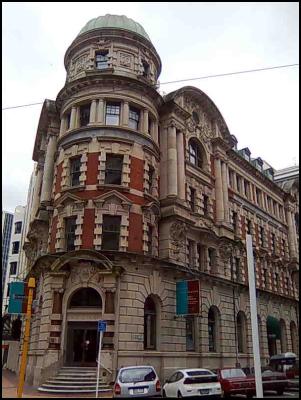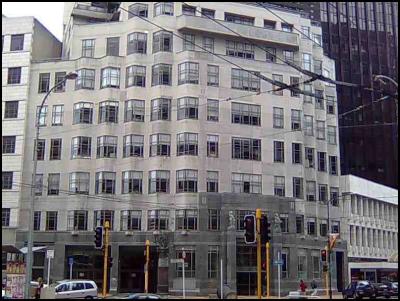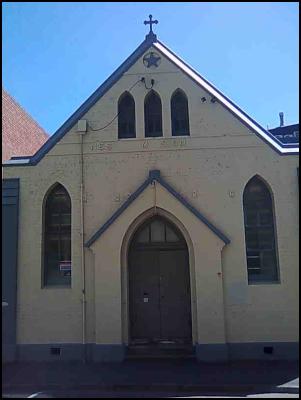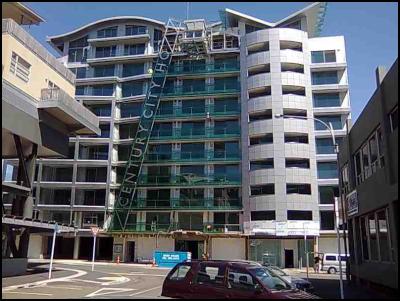Now we’re a tourist city: how Wellington’s buildings tell our story
Wellington.Scoop
By Lindsay Shelton
“I remember waking up in the morning and seeing the harbour and I had no idea it was so beautiful … it was quite extraordinary to see this incredible beauty.” – John Hopkins, NZSO conductor, on his arrival in Wellington from the United Kingdom aboard the Rangitane in November 1957.
It’s a comparatively recent pleasure to see groups of tourists in the streets of Wellington, looking at their city maps and trying to work out where to go and how to get there.
We’ve always had plenty of immigrants. Many of them used similar words to those of John Hopkins fifty years ago.
But tourists? For decades, we were told they didn’t want to come here. They flew over us from Auckland or Rotorua direct to Christchurch or Queenstown in search of world-famous scenery.
No longer. Now they come to Wellington too. They stay in hostels and motels and hotels and campervans, as well as cruise ships. And they discover that they can walk all round the city. When I see them, I feel proud that Wellington is offering them so much.
The classic Wellington things for tourists to do are well established: a cable car ride with city panoramas at the top, a stroll through the Botanical Garden, then back to town via Tinakori Road and the narrow streets of Thorndon, a walk on the waterfront including a visit to Te Papa and the 1892 bondstore which houses the Museum of Wellington, more views at the top of Mt Victoria, a drive round the bays, a meal in some recommended restaurants (including perhaps on Queens Wharf where the two restaurants are both in timber warehouses built in the 1880s).
But when visitors ask me for advice, my list is rather different because I want them to see more of our history and heritage. Just as New Zealanders in Europe expect to learn about the past by visiting remarkable old buildings, so tourists in Wellington can learn of the city’s past by looking at what has been preserved. And there’s more than they may be expecting.
First on my recommended list is Old St Paul’s, the magnificent church that was completed in 1866, a year after Wellington became New Zealand’s capital. Abandoned by the Anglican Church and now owned by the government and cared for by the Historic Places Trust, this is the most beautiful of all our timber buildings. It’s also one of the few places in Wellington which provides brochures in French, German and Spanish as well as English.
Almost as beautiful, in the centre of town, is the 1922 St Mary of the Angels, a Gothic structure in reinforced concrete which (like Old St Paul’s) has been carefully restored. Within a few blocks, there are three more fine 19th century timber churches: St Peters and St John’s (both in Willis Street), and the more severe Wesley Methodist Church in Taranaki Street.
But let’s not get ahead of ourselves. From Old St Paul’s in Mulgrave Street, it’s an easy walk to the grounds of parliament, where the three buildings make a unique contrast of architectural styles. (The oldest, the Gothic-styled General Assembly Library, was built in 1898.) From parliament, cross the road to the big government building, the one which we were always told was the biggest wooden building in the world. So what if it’s only the second biggest in the southern hemisphere. It was built in 1876 to house all government departments, and it’s been described as the country’s most celebrated attempt to replicate stone construction in timber. Victoria University’s law faculty now occupies the building, and they’ll let you look inside.
The fact that Lambton Quay (originally known as ‘the beach”) was the foreshore of Wellington is always a surprise for visitors to discover. Walking along the Quay you see some of the shoreline plaques which are a reminder of how much (more than 150 hectares) of the city was reclaimed from the harbour. (An essential Heritage Trail guide to a walk along the old shoreline was written by Michael Kelly and published by the city council in 2002. I am grateful to it for some of the information in this article).
During the walk along Lambton Quay, you also see some memorable survivors - historic buildings which show the way we were. Several were saved from demolition only as a result of vigorous public campaigns at a time when much of the Quay’s Victorian and Edwardian heritage was being pulled down and replaced.

Click to enlarge
Public Trust Buillding
Start with the Edwardian Baroque structure at131-135 Lambton Quay, affectionately referred to as the wedding cake. It was completed in 1908 as the headquarters of the Public Trust (established in 1872 to manage the trust funds of the recently deceased). It’s marvelous. Did anyone celebrate its centenary last year? Climb the front steps and take a look at its high lobby and giant winding staircase.

Click to enlarge
State Fire Insurance Building
Across the intersection: the former State Fire Insurance Building, completed in 1940 and heralding the arrival of modernism with its striking patterned façade wrapping round the corner. It has two foundation stones. The first was placed by Walter Nash when the building was new. The second, dated 1998, and placed by Tau Henare, marks a change of name to Te Puni Kokiri House, and a change of mission from insurance to “realising Maori potential.”
On the next block, Midland Park is named for a magnificent Spanish Mission style hotel, built in 1917 and sadly demolished in 1980.
Then comes the 1897 Kirkcaldie and Stains building, surviving only as a façade. Behind the façade the company continues its second century as Wellington’s oldest department store, in spaces which are sadly diminished from the original generous proportions. Next: the 1928 DIC building, with mighty Corinthian columns, which is now owned by Kirkcaldies. The individual retailers on the ground floor are a link with its past when it was another grand department store. The old-fashioned offices (windows that open! high ceilings!) on the upper floors are home for a diversity of forward-looking enterprises including Scoop.
Opposite the cable car, a façade from 1928 which is all that’s left of the head office of an Australian life assurance company. The new tower above it is occupied by the Ministry of Foreign Affairs and Trade.
Unmissably ornate is the Whitcoulls building (“a rare survivor … a poignant reminder of what Wellington has lost,” wrote Michael Kelly) which has been a bookshop since it opened in 1908.
The streamlined 1940 MLC building is notable for its honey-coloured tiled façade with art deco flourishes. Opposite the MLC are three head offices from the 1930s: there was a massive public campaign to save them from demolition.
At the end of Lambton Quay, the four Bank of New Zealand buildings are a magnificent group of classical commercial structures built between 1884 and 1904. Given to the city and intended for demolition when the bank moved to its new black tower, their fate was debated for 20 years till they were restored and reopened (as up-market shops and offices) at the end of the 20th century. And across from them, another survivor: the Stewart Dawson building which has been a jewellery business since it opened in 1901.
Keep walking along Willis and Manners Streets till you cross Cuba Street where you’ll see a fine bank building from 1913. But it’s come down in the world. No longer occupied by the bank which built it, it now serves hamburgers. A further indignity: it’s been clunkily disfigured by the clumsy addition of mismatched apartments on the roof. Opposite it, the former James Smiths building (another former department store) dates from 1907 though it had a deco makeover in 1932.
At the bottom of Cuba Street, the city’s splendid 1904 town hall, with its grand pipe organ and “patent zinc” ceiling and great acoustics.
Next come the city’s three impressive old theatres. First, the Grand Opera House, built in 1912. Two blocks further east and across the road: the St James (its foundation stone shows that it was opened in the same year, and that its original name was His Majesty’s). Try to get inside (its entrance is confusingly in the next-door building) to admire its opulent three-tiered interior.
At the end of Courtenay Place, the 1924 Embassy Theatre is easier to access because it’s open every day as a cinema. It’s been almost completely restored outside and inside (except for the ground-floor lobby) with marble stairs leading up to the high, wide and elegant auditorium which is home to the annual Wellington Film Festival.
The most marvelous discovery comes in Lower Taranaki Street, where buried remnants of the 1820s Te Aro Pa can be seen on the ground floor of a new apartment block. The remains of the old pa were uncovered when work began three years ago on the new building; construction was delayed, archaeologists moved on to the site, and now – after collaboration from many groups - everyone can see signs of life from almost 200 years ago. (Before the pa was rediscovered, the city council and the Wellington Tenths Trust published a Heritage Trail guide to the Maori history of Wellington, written by Matene Love who tells how the first Polynesian navigators arrived here in 925 AD and describes how visitors can identify 22 Wellington sites occupied by Maori in the past).
Further east, Blair and Allen Streets offer an almost intact historic streetscape of century-old market buildings. Where Tory Street intersects with Courtenay Place, the former gas company building (with the National Bank on the ground floor, apartments above) has been on the corner since 1898. Unmissable across Courtenay Place are two buildings from the 1920s: the six-storey Chicago-style 1928 Courtenay Chambers and the neo-classical 1927 National Bank, which was closed and later reopened as an ANZ branch. (The two banks now have the same Australian owner but separate branding has been maintained.)
A few blocks away are fragments of the city’s long-lost Chinatown, known to nervous or prejudiced locals at the end of the 19th century as the home of opium-smokers, gamblers and white slave traders.

Click to enlarge
1905 Chinese Mission Hall on Frederick St
Haining Street, the “street of shame” between Taranaki and Tory Streets, was most identified with the Chinese quarter. But the three remaining buildings from Chinatown are one block closer to the city, in Frederick Street. The oldest is the Chinese Mission Hall, with a little cross on top and a foundation stone laid by Frederick Bishop of Wellington on December 6, 1905. On the opposite side of the street: the Wellington Chinese Masonic Society Hall, built in 1925 and now occupied by Film New Zealand. And nearby: the arched entrance of the Tung Jung Association, with a date of 1926 above discreet double doors.
The city council has perversely placed its guide to Chinatown in Haining Street, where nothing of the past remains and where old tumbledown cottages have been replaced by bland and ordinary offices and apartments.
Something I didn’t know till I started writing this article: Wellington has New Zealand’s largest number of art deco buildings. The city council has published an excellently-detailed Heritage Trail guide to them as well, also by Michael Kelly with a significant contribution by Judy Siers. (“The research found more buildings than I knew how to cope with, and of course there were beautiful examples given the capital city requirements for head offices,” she tells me). They include the 1937 Anscombe apartments in Oriental Bay, the 1932 Free Ambulance Building in Cable Street, and the City Gallery (built as the City Library in 1939 and currently closed for extensions) in Civic Square. Then there’s the 1931 National War Memorial and Carillon which are in front of the former National Museum (now Massey University’s Wellington campus). And back to Willis Street to the splendid Hotel St George, built in 1930 and now a student hostel. Anyone who was here in the 1960s knows that the Beatles stayed there.
And what of contemporary buildings? What to recommend to tourists from the new architecture which is changing Wellington streetscapes and bringing more people into the city?
Three massive examples from two of our most high-profile architects can serve as an introduction.
First: you can’t miss Ian Athfield’s much-admired, welcoming and well-used Central Library which dominates the southern end of Victoria Street and features rows of iconic nikau palms. It still seems new, though it was opened more than 15 years ago.

Click to enlarge
Ian Athfield Apartments Chews Lane
In the same street, above the recently re-created Chews Lane and its group of impeccably-restored buildings which make up a mini-history of architectural styles: the huge and elegant Athfield-designed apartment building occupying previously empty space which is now defined as levels 8 to 19. Somehow it’s almost invisible from the streets below. When you discover it, it seems to be floating in the sky, though this is probably not the perception of its neighbours on the opposite side of Willis Street.

Click to enlarge
Century City Hotel, Tory St.
The third example, looming over narrow Tory Street, is just as enormous but somewhat less restrained: the Roger Walker-designed Century City Hotel (is futuristic a word for it?) with curving roof lines and balconies of different shapes and materials, some of them jutting out over the traffic-challenged street below. There’s nothing like it anywhere else in Wellington.
There are many more recent buildings which have made parts of town unrecognizable if you haven’t been in them for a couple of years. They deserve their own separate story.
Let’s end by going back to where we began. For visitors who want to know more about the Treaty of Waitangi, the real thing from 1840 (with all nine documents and all the signatures) can be seen in Wellington – not at Te Papa but at Archives New Zealand, a couple of minutes walk from Old St Paul’s in Mulgrave Street.
The Treaty is on display (from 10 till 4, Monday to Friday) in the Archives’ dimly-lit Constitution Room. This piece of reality from the earliest days of European settlement – with a startling history of being forgotten and rediscovered and damaged and repaired - is viewed in an atmosphere which seems more quiet and hallowed than in the beautiful nearby church which the Anglicans didn’t want.’
ENDS




 Eugene Doyle: BBC Goes Full Goebbels In Support Of Israeli Soccer Hooligans
Eugene Doyle: BBC Goes Full Goebbels In Support Of Israeli Soccer Hooligans Binoy Kampmark: They Were There First - Election Denialism, The Democratic Way
Binoy Kampmark: They Were There First - Election Denialism, The Democratic Way Martin LeFevre - Meditations: Self-knowing Is The Gateway To Liberation And Transmutation
Martin LeFevre - Meditations: Self-knowing Is The Gateway To Liberation And Transmutation Alastair Thompson: Google's Support For Democracy And Media In NZ | Part 1 - The Digital Media Bargaining Bill, NZME, STUFF & Google
Alastair Thompson: Google's Support For Democracy And Media In NZ | Part 1 - The Digital Media Bargaining Bill, NZME, STUFF & Google Binoy Kampmark: The Remembrance Day Amnesia Racket
Binoy Kampmark: The Remembrance Day Amnesia Racket Gordon Campbell: On The Crown’s Sorry Excuse For An Apology
Gordon Campbell: On The Crown’s Sorry Excuse For An Apology